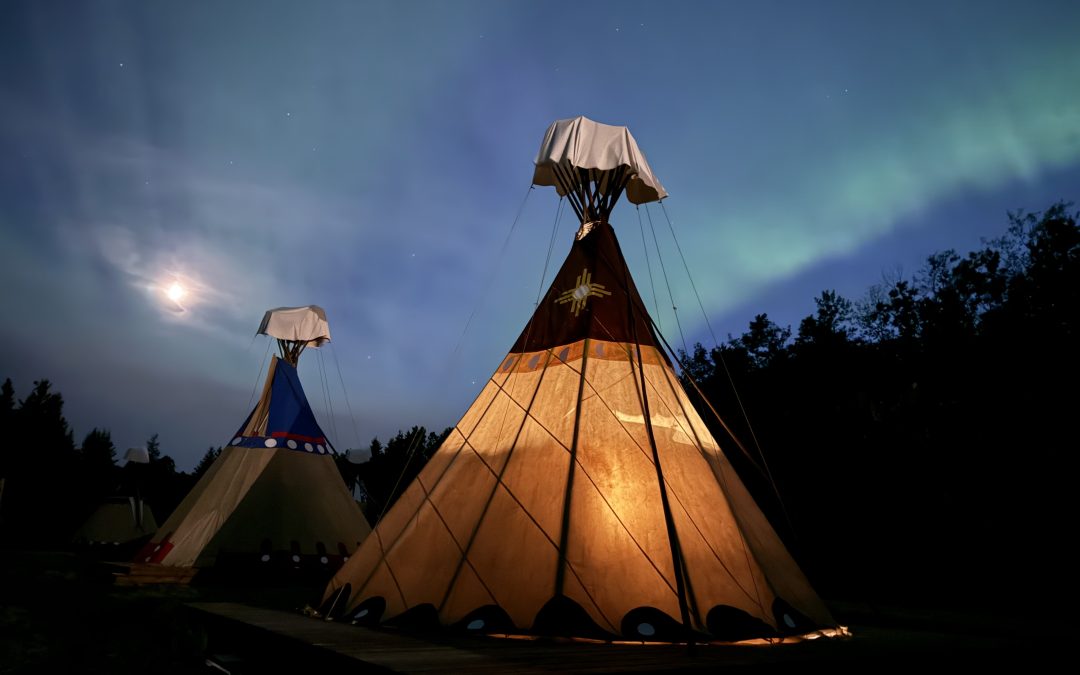This post contains affiliate links.
I was told I’d be blown away by Saskatchewan. And I was. Quite literally, with hair whipped into a tangled mess, head tipped windward, in defiance. We were here to embrace an Indigenous tourism Saskatchewan experience. But who knew a prairie province, branded as the wheat fields of Canada, could be a contender for water wind sports?
Ah yes, the water. Saskatchewan has lots of it north of Saskatoon, in the boreal forest. Think more lake country than prairie in these regions.
Big sky
But Saskatchewan is really all about the sky. Big, open and expansive – a horizon line uninterrupted. A pallet of ever changing colours, at the hand of mother nature, and her deft use of tone and light. Here the sky offers a weather visual of what is to come, or what has just passed, and on many days, what is currently blowing through.
Our trip to Water’s Edge Eco Lodge embraced that big sky. Sunrise, sunset, starry night with Indigenous storytelling, plus an epic northern lights show.
The Boreal forest
Deep in the heart of the boreal forest lies a place laced with hundreds of lakes, and a rich Indigenous culture rooted in the land. Visiting this area will reconfigure all previous bias you may have had about Saskatchewan, dismissing it as prairie flat land.
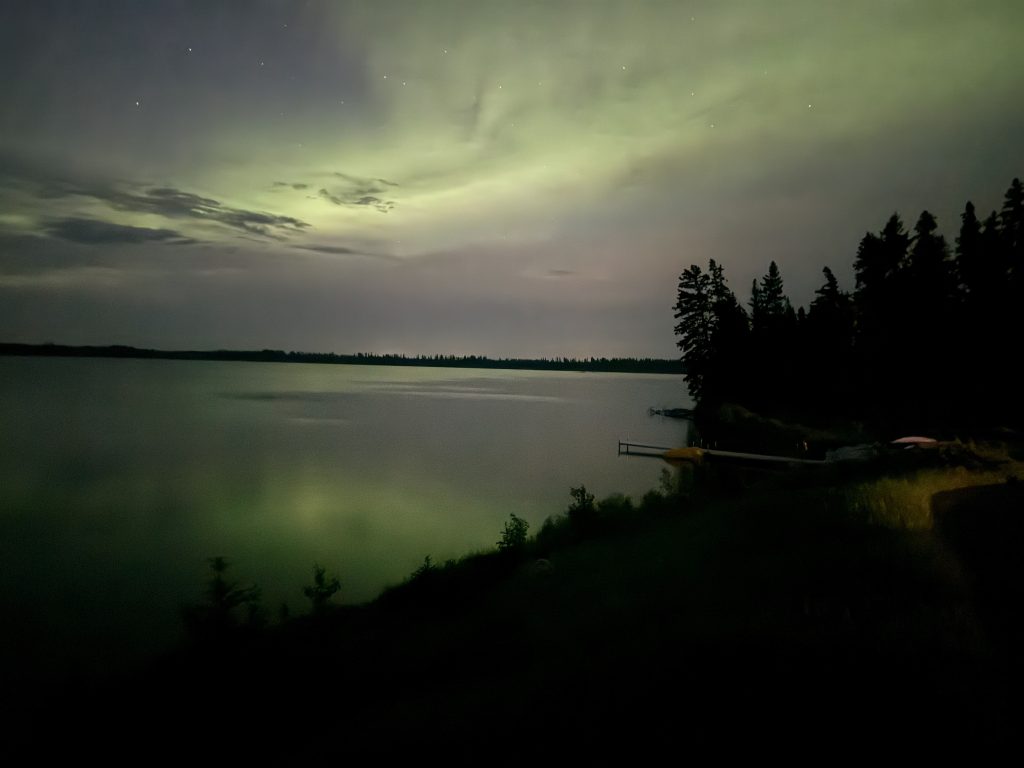
Part 1 of this series, “Saskatchewan Through an Indigenous Lens”, took you to kâniyâsihk Culture Camp. Our second Indigenous Tourism Saskatchewan experience, on a pre-conference media tour for the Travel Media Association of Canada, was quite different, but equally rewarding.
Water’s Edge Eco Lodge
Water’s Edge Eco Lodge is an all-season lakeside retreat, nestled between the waters of Greig Lake and the forest of Meadow Lake Provincial Park. It is about 375 km north west of Saskatoon, in the heart of the boreal forest. https://watersedgeecolodge.ca/
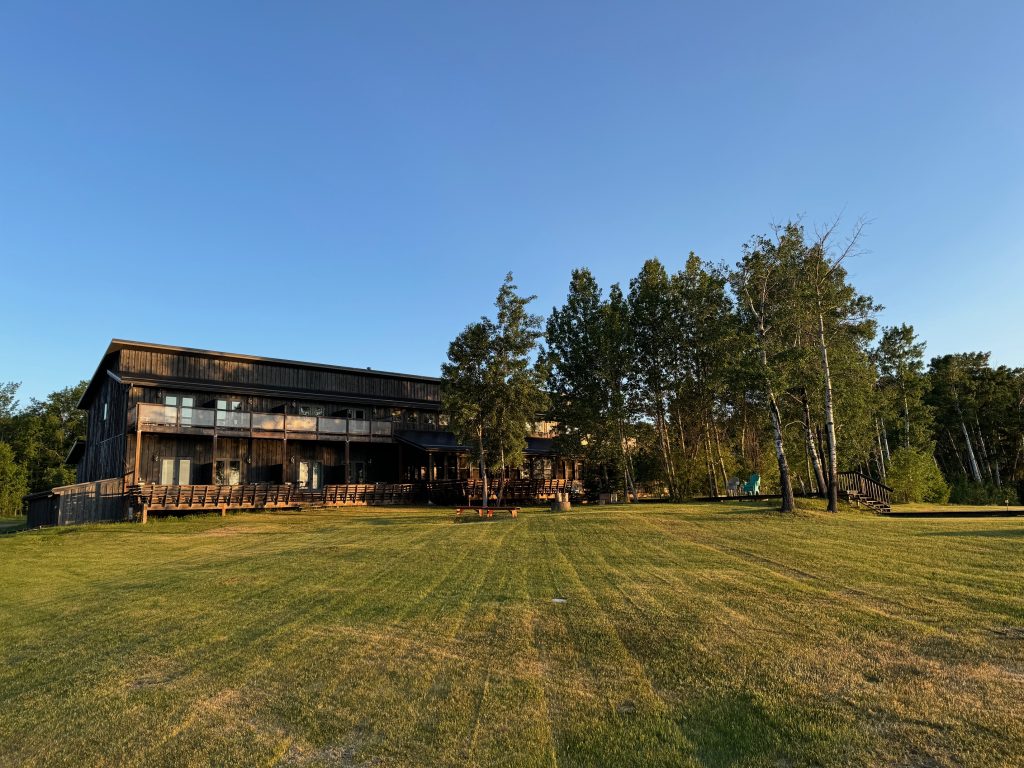
Water’s Edge is proudly owned and operated by Waterhen Lake First Nation, and sits on historic trapping and fur trading land. Waterhen Lake First Nation became new owners of the property in spring 2022, presenting an exceptional opportunity for the group to showcase traditional culture.
First Nation entrepreneurship in action
Destiny Millar, the Lodge Manager, was our host. First Nation elders and band youth shepherded us through learning about the night sky, Indigenous culture, and traditional medicines, harvested from plants in the area.
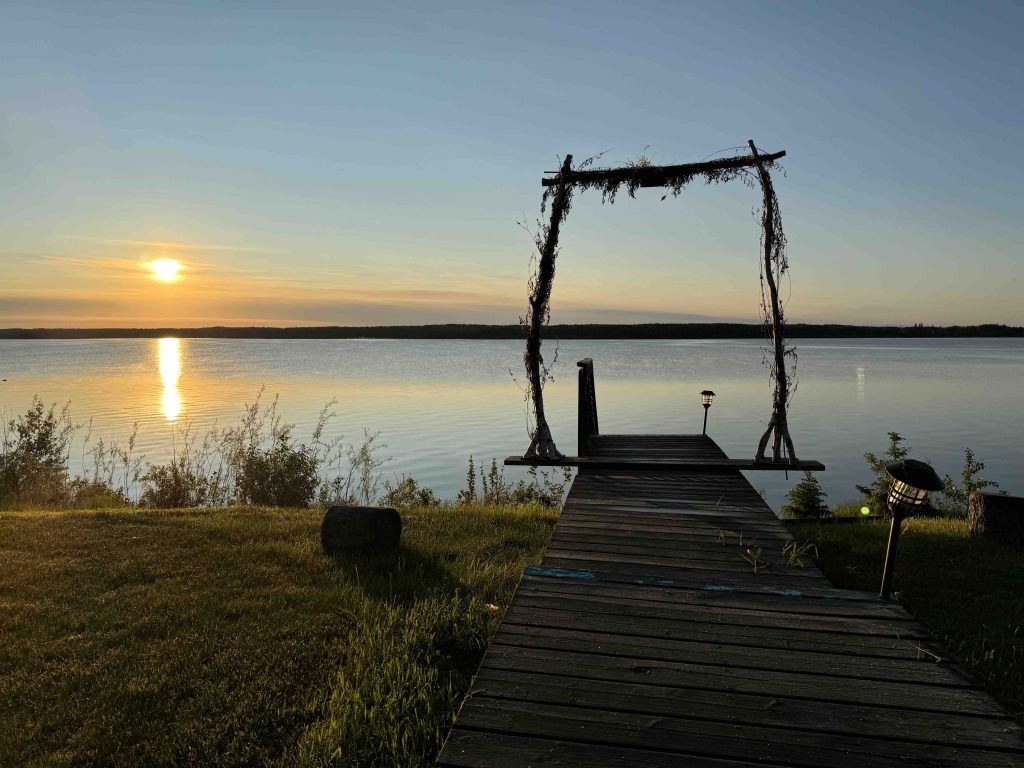
We are all students
Canada has much to learn from its Indigenous populations. I’m reminded of this at kâniyâsihk Culture Camp, and again at Water’s Edge Eco Lodge, as we meet business owners and staff who are spiritually mature, rooted in community and connected to the land. The matriarchal underpinnings of Indigenous society also teaches us compassion for each other, care for mother earth, and soft power earned through respect.
These teachings were evident at every turn. It was a gentle reminder that if we are open to learning as a society, and growing together, we all benefit.
Tipi accommodation
Nothing screams Indigenous experience like sleeping in a tipi though, albeit a modern version blending the best of traditional design, with an upgraded yurt glamping style feel inside.
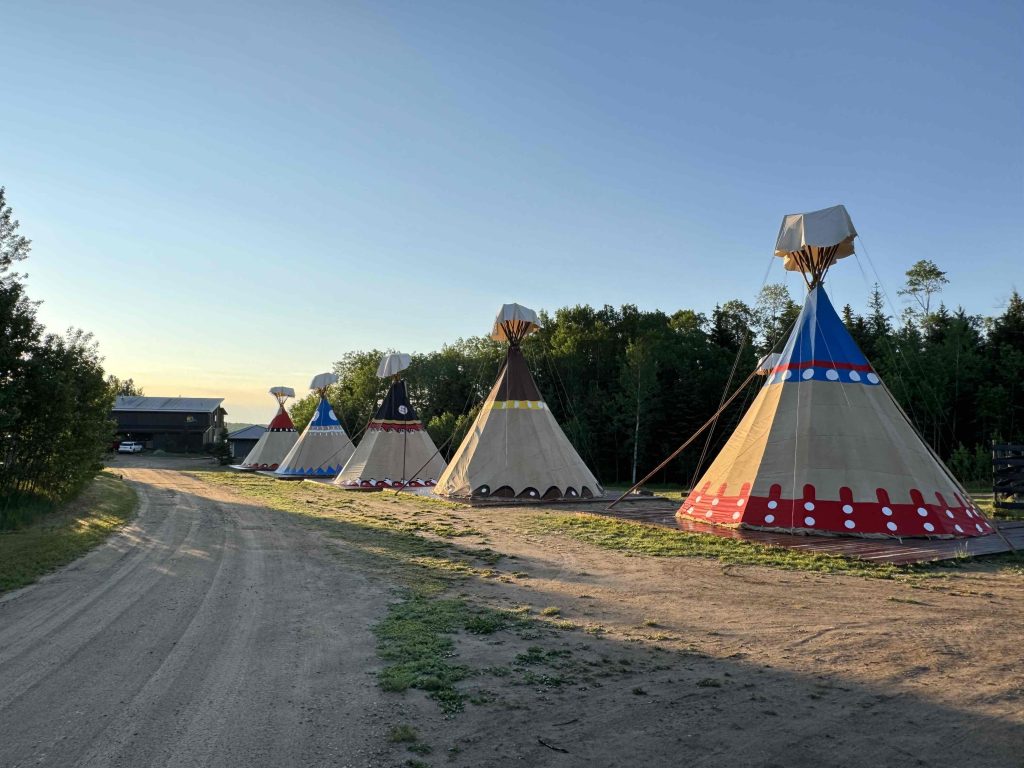
Water’s Edge Eco Lodge has installed 10 tipis on platforms this season, well-spaced from each other for privacy, along the road to the lakeside lodge. Together with eight lake front guest rooms in the main lodge, and three self-contained lakefront rental cottages, the property is well set up to welcome guests. They also host visitors in their dining facility, a screen porch overlooking the lake.
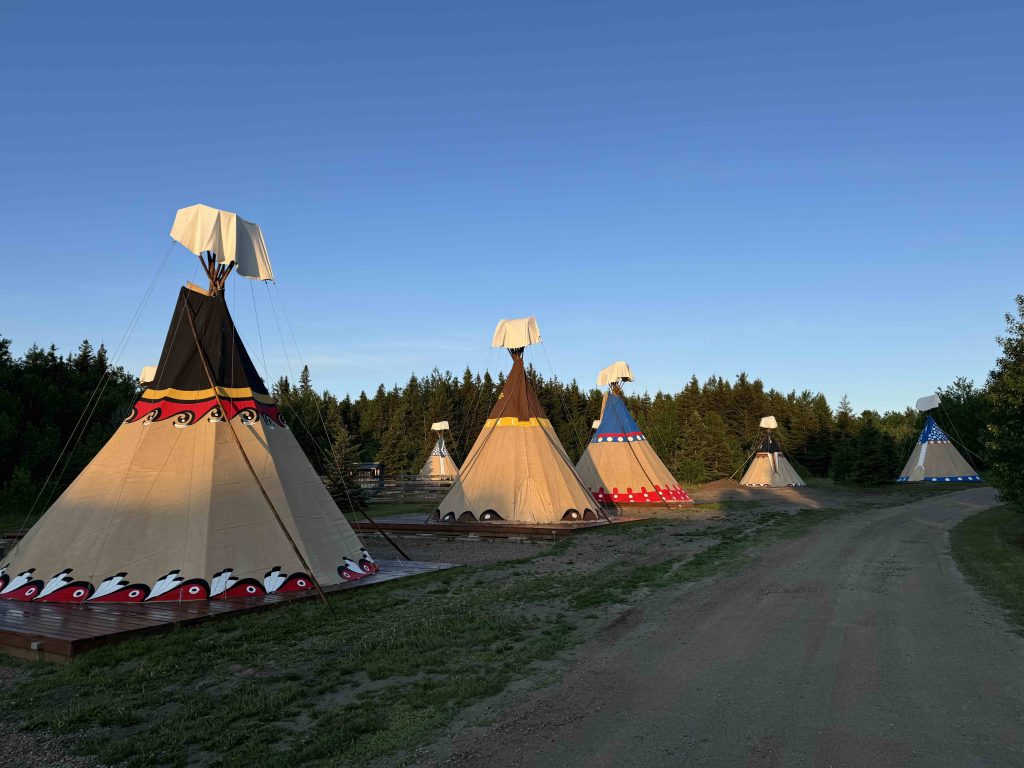
The tipi village had a soft opening in the fall of 2024, so summer 2025 is their first full season.
We each had our own private tent, nicely appointed with a queen bed, couch, lounge and small bistro table, plus coffee makers, fans and heaters to moderate temperatures. With only a small vent hole at the top (covered for rain), tipis can get quite hot, or quite cold, depending on outside temperatures.
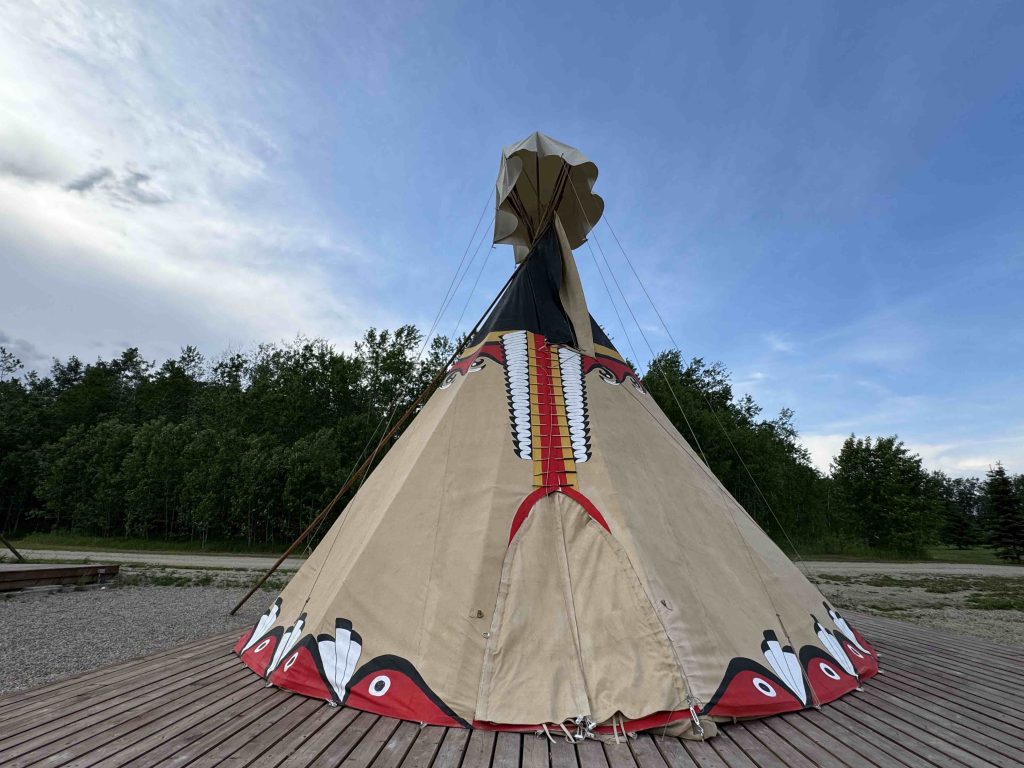
In our case we got to experience night time temperatures of 5C, which put the duvets and heaters to the test. Private bathrooms and showers were located a short walk away.
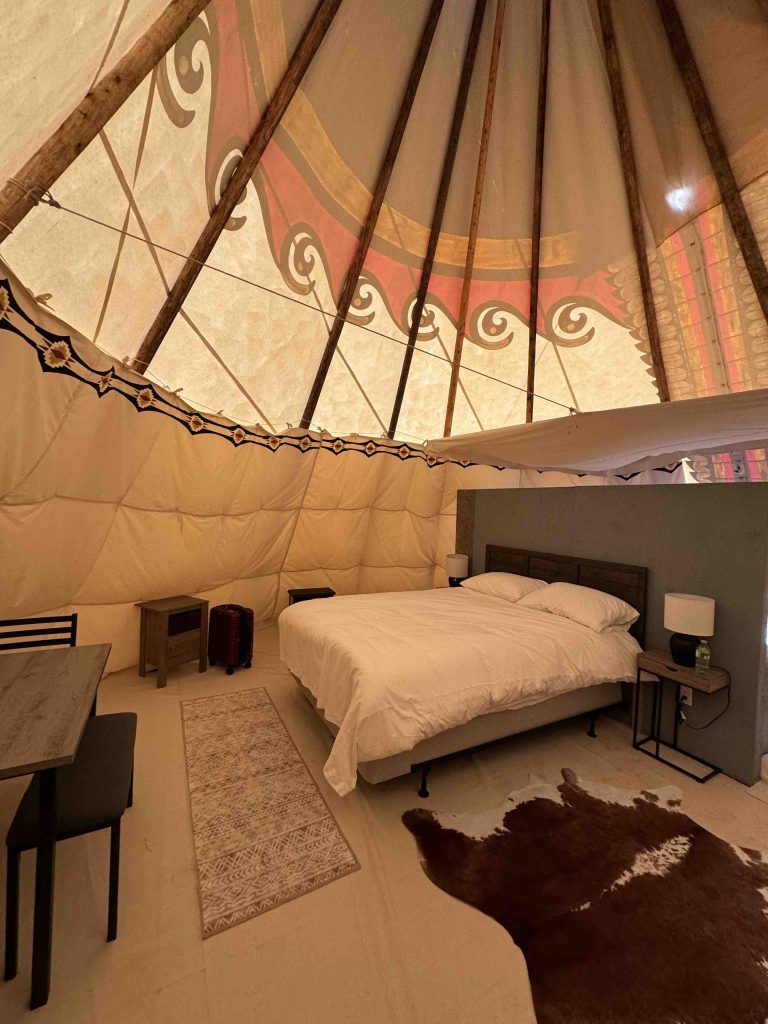
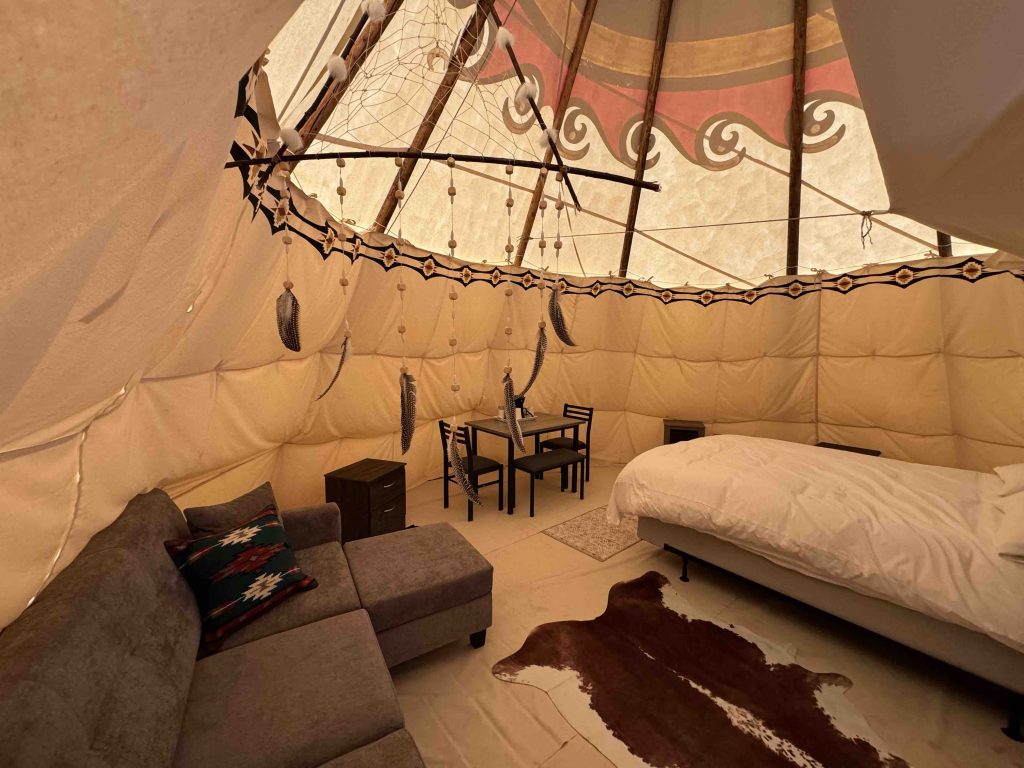
Night sky storytelling
Once checked in, we joined our guides Edwin and Jayden, a couple young members of the Cree Nation, plus an elder, for a night sky storytelling session. The boys early season scripted reading of stories will no doubt be replaced by increasing candor and confidence, as the stories become committed to memory with practice. Employing youth to ensure traditions and knowledge are passed down through generations, is just one of the outcomes from Indigenous ownership of this property.
The stars
We used the “Stellarium app” to help identify stars in the sky by location, and bring the starry night to life, as Edwin and Jayden shared stories about the Big Dipper, Cassiopeia and Polaris (the north star).
Polaris
We learned that Polaris is the one star that never moves. “We believe it was placed by the creator, so no matter where you go, and how far, it will always guide you home” noted Edwin. If you place Polaris on your right shoulder, you go west. If on your left shoulder, you go east. Who knew? But the learning was just beginning…
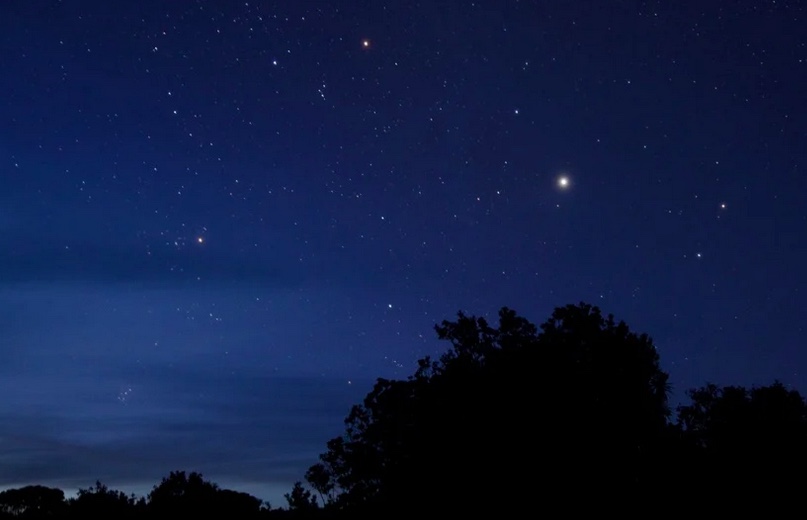
Big Dipper
The Big Dipper represents the Great Bear to the Cree. The four stars of the Big Dipper’s bowl are represent the body of the bear, while the three stars of the handle are interpreted as hunters pursuing it.
Cassiopeia
We also learned about Cassiopeia representing Niska, the Goose. The W-shape of Cassiopeia looks like geese flying in formation. To the Cree this formation is a reminder of the power of community, family and teamwork. Elders say the lead goose works the hardest, but when it tires, another takes its place, and the rest encourage with their voices.
We’re all connected
Everything is connected to nature in Cree culture. Jayden continued, “The sun shields us by day, bringing warmth, light and the energy of growth. The moon watches us by night, giving rhythm, reflection and peace. The earth nourishes us with food and medicine. The stars guide our way, sharing stories and showing us our place in the universe. When we honour these connections, we honour the creator and ourselves.”
Northern Lights (aurora borealis)
Saskatchewan is located in a unique position under the aurora oval, which is why northern lights can be observed all year long. So I had asked my fellow travel writer friends to promise to wake me up if the lights made an appearance, assuming I wasn’t already out observing.
You can’t exactly knock on a tipi door, so around 1am I heard my name being called on the other side of the canvas tent wall. It was a cold evening, and tough to haul myself out from under a warm duvet, but it was so worth it.
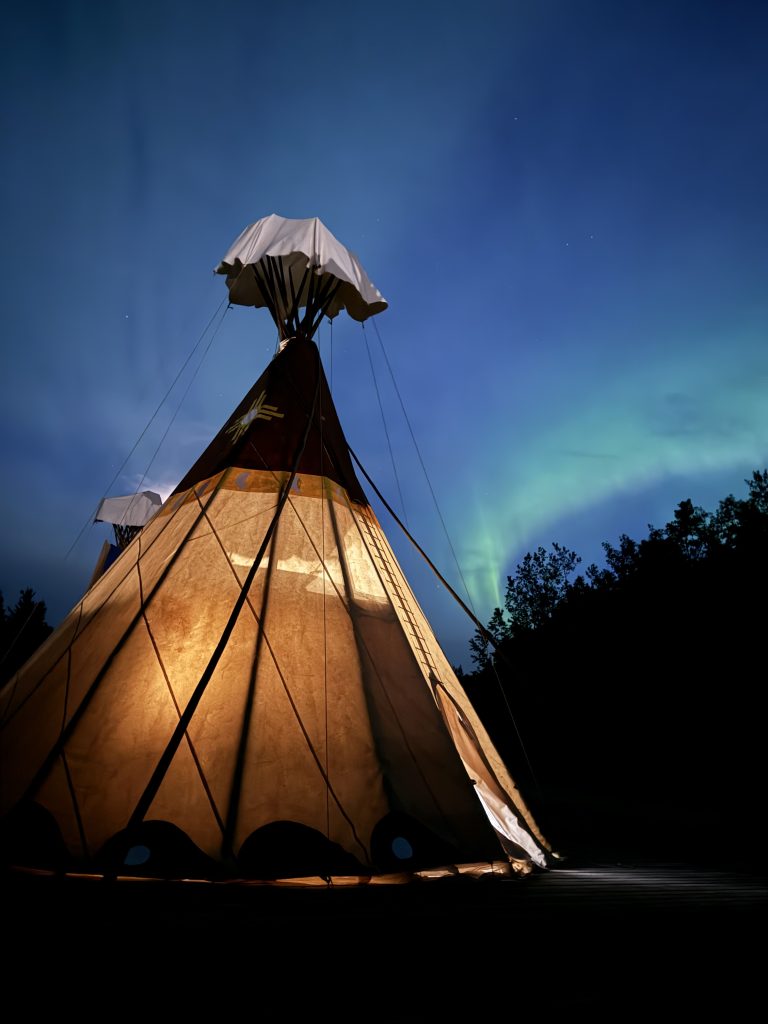
Saskatchewan is a great place to witness Northern Lights
While Canada’s North West Territories boast 240 nights/year of northern lights, Saskatchewan clocks an average of 3 nights/week from late August to April, with lights visible year round, averaging 150 nights/year. That made our odds pretty solid during the two night stay, and mother nature did not disappoint.
Bundled up and staring at the ever shifting glow – a pallet of green, white and pink, against an otherwise dark sky was magical. The tipi illuminated in the foreground further added to the drama, reminding us we were guests on this indigenous land. The show further connected us to mother earth.
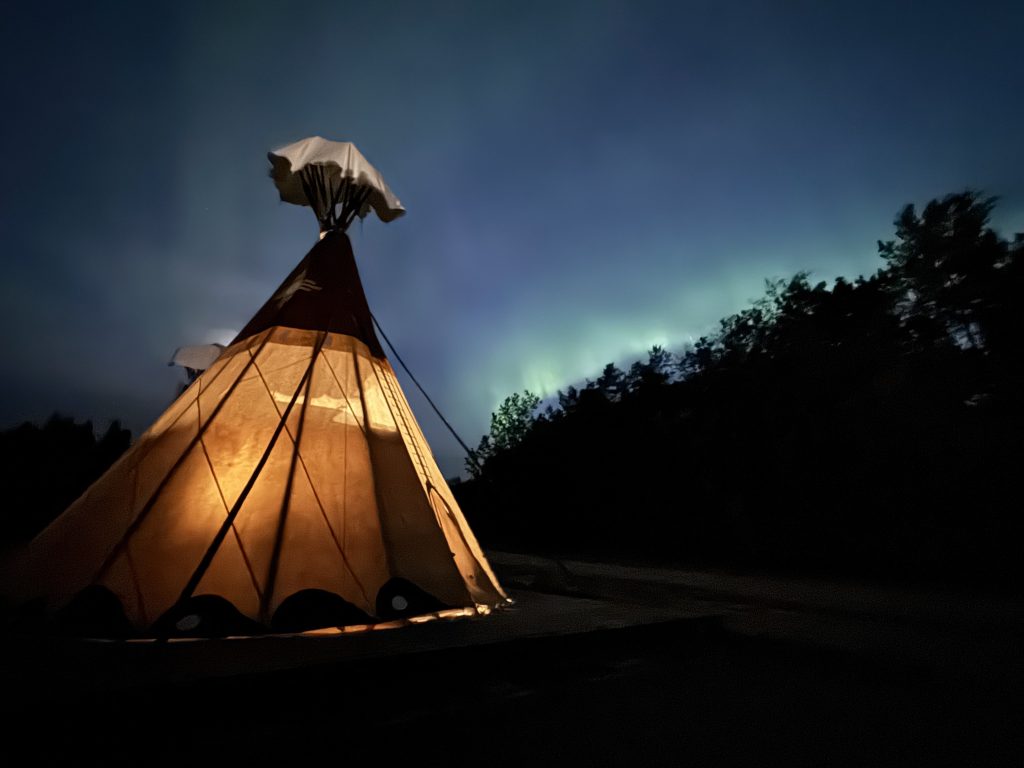
The view from the water’s edge over the lake, with the arora’s reflection, seemingly doubling mother nature’s canvas, was magical.

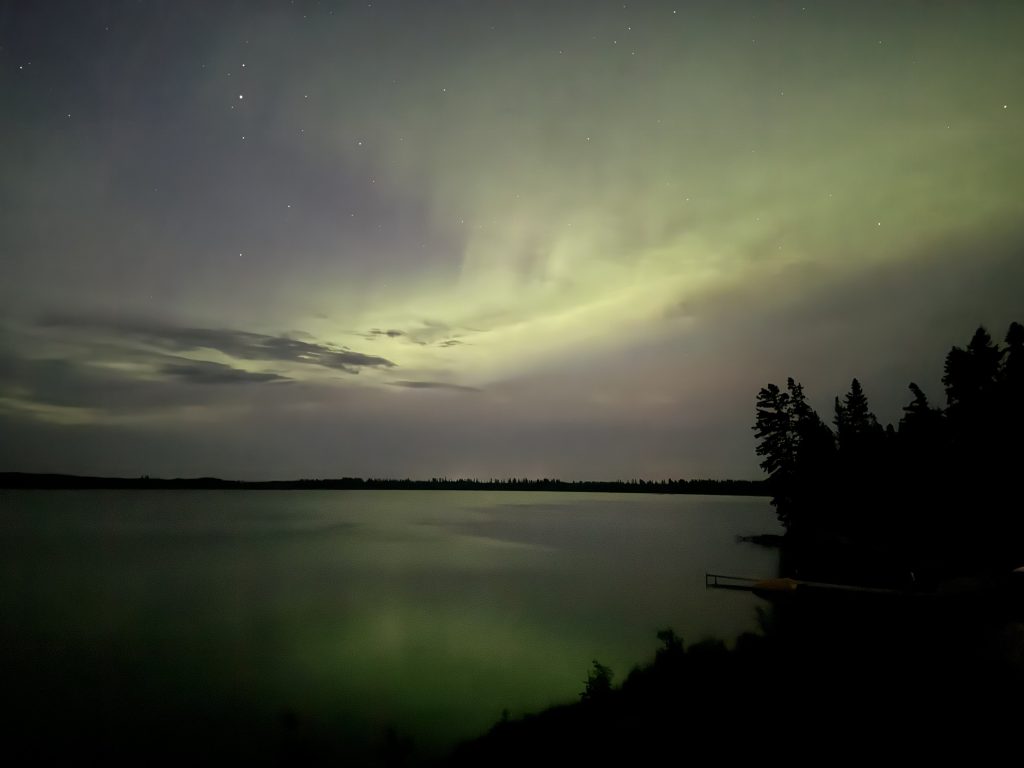
Morning sunrise
The truth is, I’m not sure I actually slept much after the aurora light show. I tried unsuccessfully to warm up from the chilling night air. Eager to see sunrise over the lake, I woke still fully dressed at 4:30am, and crawled from my tent to witness the quiet peace of morning golden hour with nobody else around.
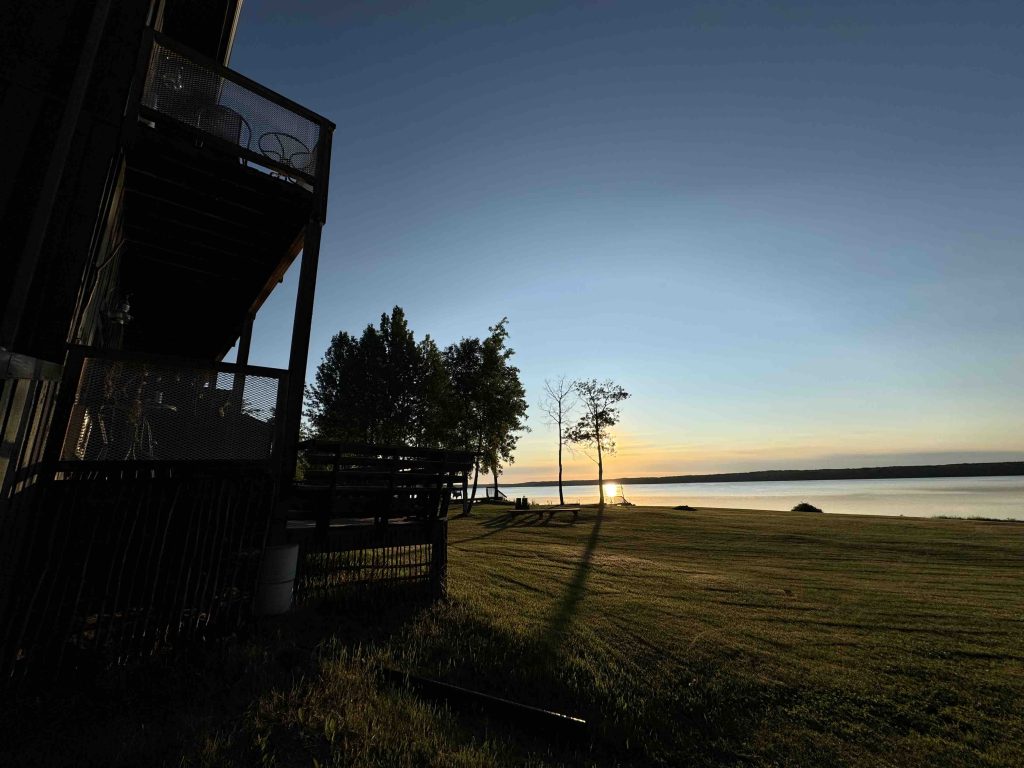
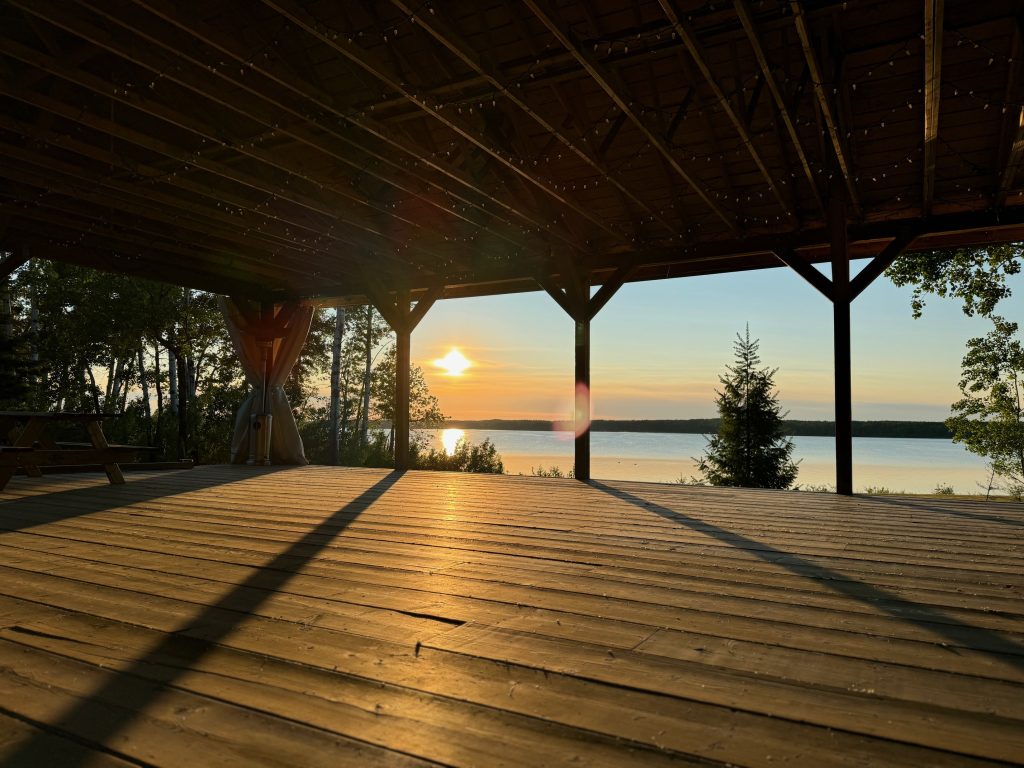
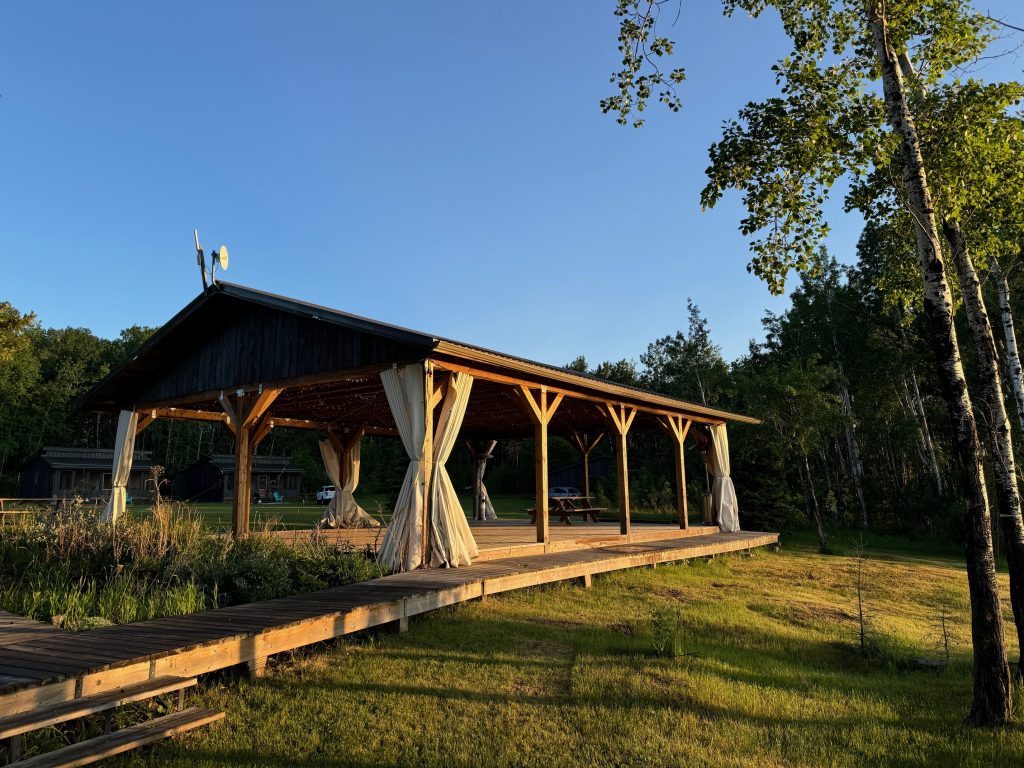
Meadow Lake Provincial Park
After breakfast at the lodge, we ventured to Meadow Lake Provincial Park for a nature walk. Kimball Lake Trail is part of the boreal trail system.
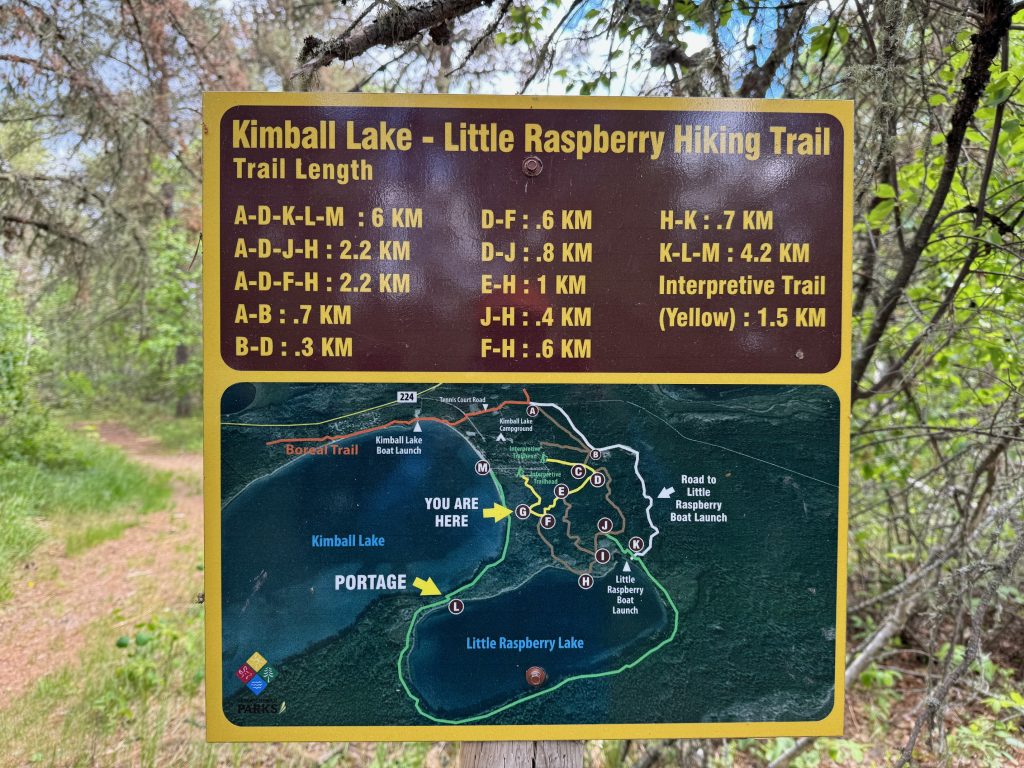
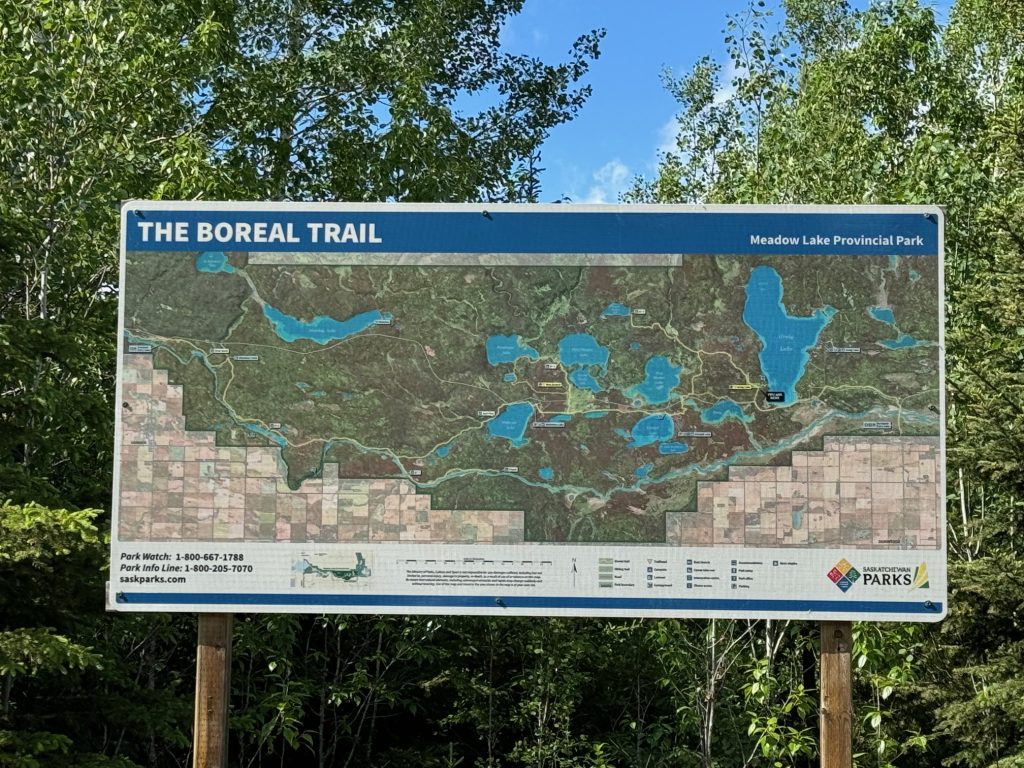
Spanning over 1,600 km and featuring more than 20 lakes, rivers and streams Meadow Lake Park is one of the largest provincial parks in Canada.
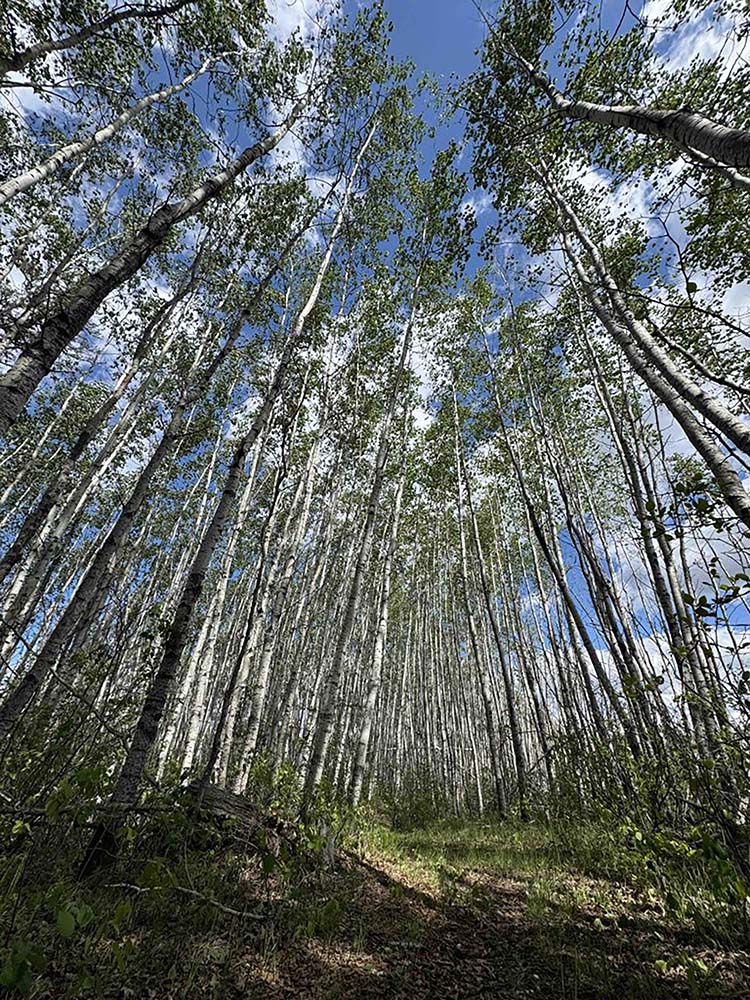
We witnessed it early season in June, before summer family vacationers and adventurers, so it was quite quiet. The park offers excellent fishing, and water based activities. Day-hike and multi-day hike options are also popular during the summer season.
Indigenous plants walk
Back at the lodge, we were lead on an Indigenous plants walk by Cree elder, Rose Richardson. Destiny, the lodge manager, also joined us.
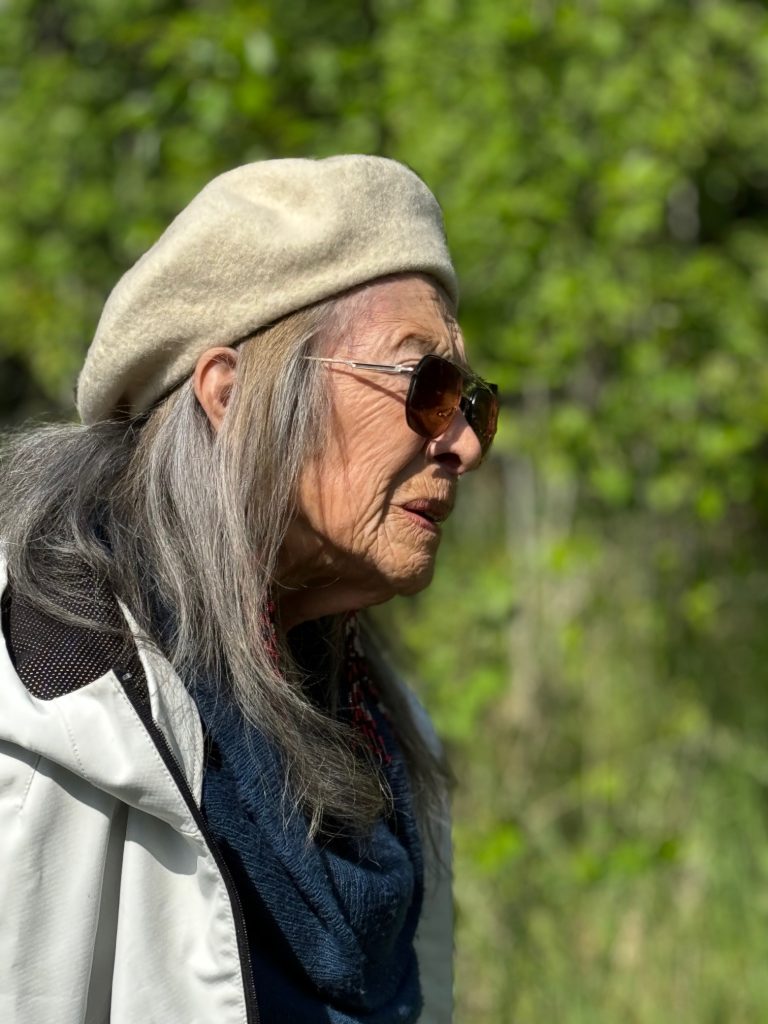
At 86 years young, Rose is a woman of style, sporting a white pant suit, a generous smile, and gentle ease. Rose is deeply knowledgeable, pointed out plants and their medicinal uses, as she gently guides us along a path through the bush. Rose became an advocate for the land and plant based natural medicines, caring for her late husband Rod Bishop, former mayor of Green Lake.
She now works with over 150 plant medicines. Rose claims to “read the plant” to see what emerges as its purpose, believing the creator speaks to elders in dreams and visions. She is a big believer in “Indigenous ways of knowing”, a non-science knowledge base, increasingly of interest to those outside the culture. Indigenous ways of knowing taps knowledge, founded on the ancestral relationship Indigenous people have with their surroundings.
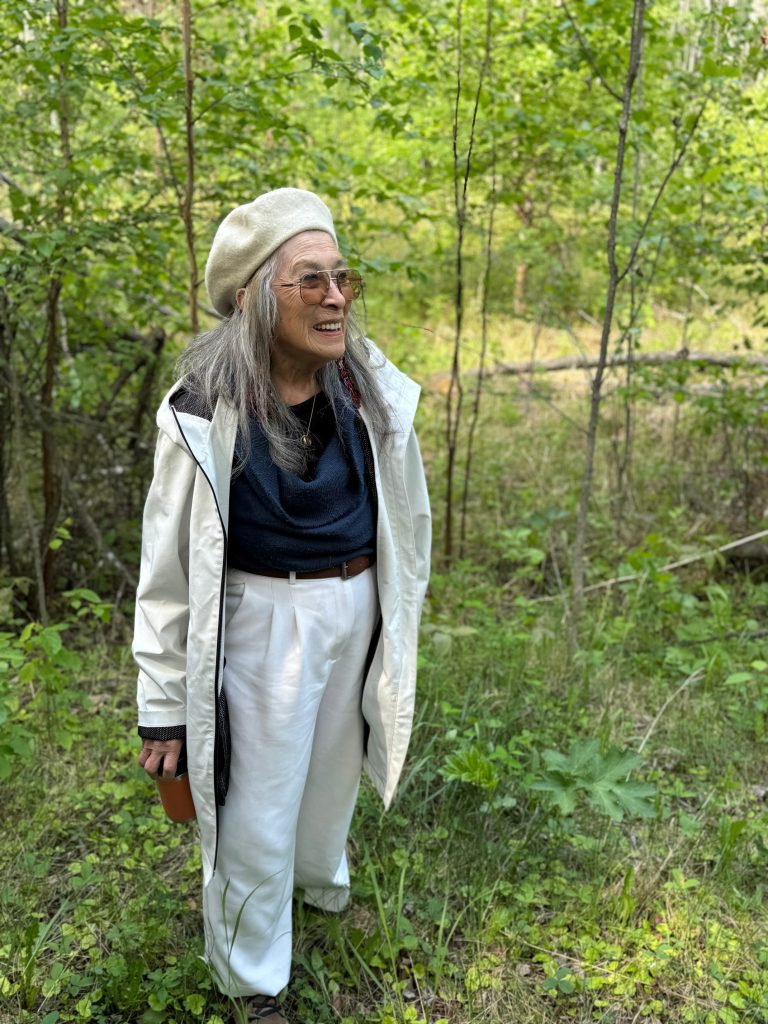
What might we treat with plant medicines? We learned that morel mushrooms can help with infertility, fatigue and respiratory issues. Rabbits root is for coughs, fevers and colds. Rosehip is useful for eye ailments and digestive issues. Cow parsnip is your plant of choice for sore joints and skin issues. Horse tail brewed as tea is a diuretic and good for bladder issues. And haskap helps reduce hypertension, but it can also be used to flavor gin. Ok, so there were a few additional uses noted!
Tipis
Water’s Edge Eco Lodge has a tipi skeleton structure down by the water, which Edwin used to educate us on the symbolism of the tipi. Cree tipis are constructed from 15 poles, with the first 3 set like a tripod. Typically a range of 15-20 poles can be used for larger structures. Each pole added has meaning.
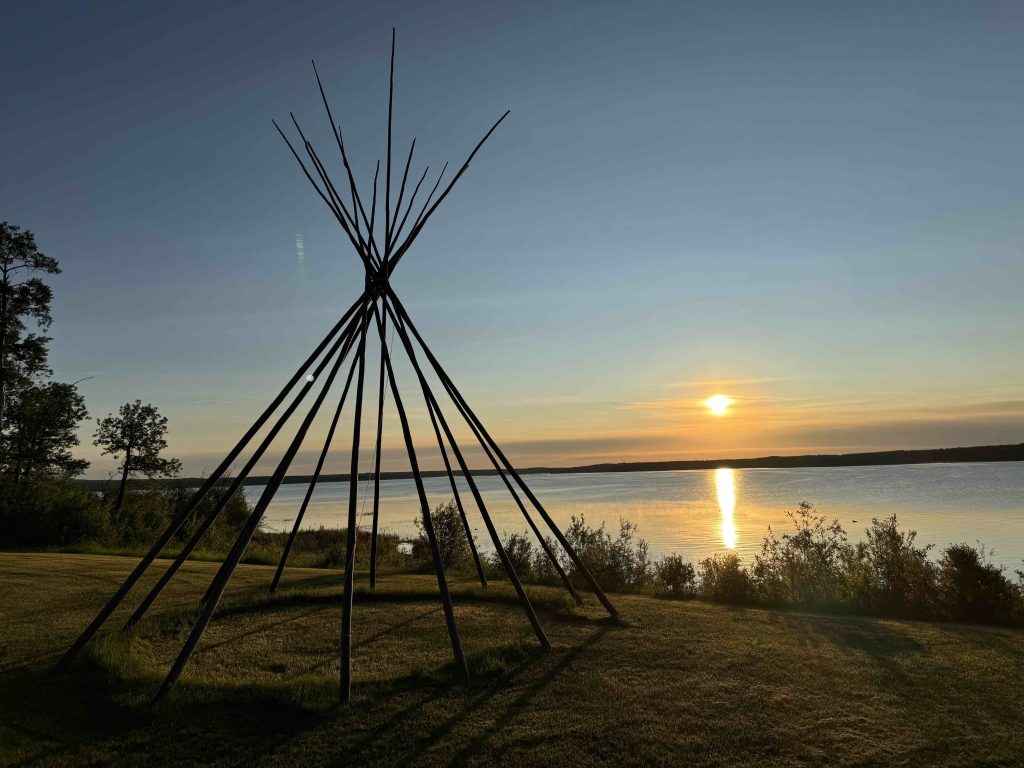
A strong community needs all we learned, each pole representing how members help each other. Tipi’s are built in a circle, representing family, with a fire in the center, representing the heart. The tipi door always faces east, where the sun rises, a welcome to new beginnings. The smoke hole is said to let stories and prayers rise to the creator in the sky.
The first 3 poles placed are the most important though. They represent obedience, respect and humility. Forming the initial tripod of the structure, they also represent lessons of childhood.
What the poles represent
- Obedience
- Respect (for nature and self)
- Humility
- Happiness (joy, laughter)
- Love (family, friends, community)
- Trust (creator)
- Kinship
- Cleanliness
- Thankfulness (gratitude)
- Sharing
- Strength
- Good child rearing
- Hope (future)
- Ultimate protection
- Control flaps (at door entrance, arms of mother, protection)
- Guidance
- Generosity
- Compassion (acts of kindness)
- Patience
- Understanding
The belief is that every pole matters, every story matters, and every person matters.
Water’s Edge Eco Lodge was a more curated recreation experience than kâniyâsihk Culture Camp. The property is set up as a resort, to host summer visitors, families, and special events. The outdoor covered pavilion down by the water makes the location fabulous for weddings.
Being Indigenous owned, with a desire to also educate visitors about native culture, Water’s Edge Eco Lodge offers a great blend of recreation and learning.
Time stands still in Saskatchewan
If you plan to visit Saskatchewan, there are a few other timely reminders that will serve you well. Time stands still in Saskatchewan because it is the only province in Canada to not observe daylight savings time. While the practice keeps milking cows regular, year round standard time can mess with visitors arriving from another province or catching a flight, if not aware of the practice. So be mindful in your planning.
Is Saskatchewan more than straight road prairies, farms and grain elevators? Absolutely. Seen through an Indigenous lens, the provinces history, culture and natural surroundings take on new meaning.
And frankly, nothing beats a Saskatchewan big open sky. Especially when the elders ask the creator to turn on the northern lights! It was a sacred experience, deeply felt, and to be forever remembered.
Learn more about Saskatchewan in this post: Saskatchewan Indigenous Tourism at Kaniyasihk Culture Camp.

